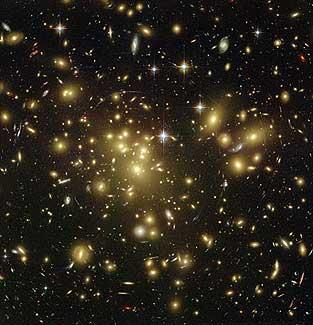ASTRONOMY, being one of the seven liberal arts and sciences it behoves us as Masons to pay respect to the great discoveries of our time!
The Advanced Camera for Surveys aboard NASA's Hubble Space Telescope took this photo using a 13 hour exposure time and a natural "zoom lens" in space to boost its view of the distant universe. This lens consisted of the gravity of the trillion stars of one of the most massive galaxy clusters known, called Abell 1689, which is located 2.2 billion light-years away and acts as a "gravitational lens" which bends and magnifies the light of galaxies located far behind it.
Hubble astronomers speculate that some of the faintest objects in the picture are probably over 13 billion light-years away.
The picture is an exquisite demonstration of Albert Einstein's prediction that gravity warps space and therefore distorts a beam of light, like a rippled shower curtain. Though Einstein realized this effect would happen in space, he thought it could never be observed from Earth. Though individual stars lens background light, the deflection was too small to ever be seen from Earth.
For more details check out:
article about background picture on our home web page
You can find Hubble pictures and information at:
Hubble pictures and information

More: Hubble and Keck Team Up to Find Farthest Known Galaxy in Universe
More about gravatational lenses.
And since one of the seven great arts and sciences is ASTRONOMY here is this.

Source: Hubblesite.org
ABOUT THIS IMAGE:
This craggy fantasy mountaintop enshrouded by wispy clouds looks like a bizarre landscape from Tolkien's
"The Lord of the Rings" or a Dr. Seuss book, depending on your imagination. The NASA Hubble Space
Telescope image, which is even more dramatic than fiction, captures the chaotic activity atop a
three-light-year-tall pillar of gas and dust that is being eaten away by the brilliant light from
nearby bright stars. The pillar is also being assaulted from within, as infant stars buried inside
it fire off jets of gas that can be seen streaming from towering peaks.
This turbulent cosmic pinnacle lies within a tempestuous stellar nursery called the Carina Nebula,
located 7,500 light-years away in the southern constellation Carina. The image celebrates the 20th
anniversary of Hubble's launch and deployment into an orbit around Earth.
Scorching radiation and fast winds (streams of charged particles) from super-hot newborn stars in
the nebula are shaping and compressing the pillar, causing new stars to form within it. Streamers
of hot ionized gas can be seen flowing off the ridges of the structure, and wispy veils of gas and
dust, illuminated by starlight, float around its towering peaks. The denser parts of the pillar are
resisting being eroded by radiation much like a towering butte in Utah's Monument Valley withstands
erosion by water and wind.
Nestled inside this dense mountain are fledgling stars. Long streamers of gas can be seen shooting
in opposite directions off the pedestal at the top of the image. Another pair of jets is visible
at another peak near the center of the image. These jets (known as HH 901 and HH 902, respectively)
are the signpost for new star birth. The jets are launched by swirling disks around the young stars,
which allow material to slowly accrete onto the stars' surfaces.
Hubble's Wide Field Camera 3 observed the pillar on Feb. 1-2, 2010. The colors in this composite
image correspond to the glow of oxygen (blue), hydrogen and nitrogen (green), and sulfur (red).
Object Names: HH 901, HH 902
Image Type: Astronomical
Credit: NASA, ESA, and M. Livio and the Hubble 20th Anniversary Team (STScI)
Just imagine a race of human type inteligent people like us living on a planet circling a star near
these structures. What an inspiring sight for a spooning couple parked by a lake at night!
Astronomy Magazine
Sky and Telescope Magazine
space-astronomy magizne
The Very Long Baseline Array
Chandra X-Ray Observatory
The Chandra X-rayThe Chandra X-ray Observatory is the world's most powerful X-ray telescope. It has eight-times greater resolution and is able to detect sources more than 20-times fainter than any previous X ...
is the world's most powerful X-ray telescope. It has eight-times greater resolution and is able to detect sources more than 20-times fainter than any previous X ...
Chandra X-ray Observatory Center, Gateway to the Universe of X-ray Astronomy
Chandra X-Ray Observatory
Spitzer Infrared Space Telescope
Lowell Observatory
A 4.3-meter telescope rising seven stories above the top of a cinder cone forty miles from Flagstaff.
The website of the Palomar Observatory.
W. M. Keck Observatory
Comprised of two ten meter telescopes includes information on equipment and instruments, with images and movies, observing information, and news.
Mount Wilson Observatory
Founded in December 1904 by George Ellery Hale, Mount Wilson Observatory would quickly rise to dominate astronomy worldwide.
It was successively home to the world's two largest telescopes as well as the most powerful facilities in existence for
studying the sun. Those pioneering instruments and the brilliant scientists who used them revolutionized astronomy through
such discoveries as:
relocating the sun far from the center of the Milky Way galaxy
the existence of countless galaxies and an enormous Universe
the magnetic field of the sun and its key role in solar activity
the recession of the galaxies implying the Big Bang
populations of stars of various ages
In the twenty-first century, the Observatory hosts several of the most technologically advanced facilities in the world for
studying astronomical objects with unprecedented resolution and clarity. The 100-inch Hooker telescope remains in active
scientific service, and the solar towers are daily collecting data representing the world's longest continuous record of the sun.
Physorg - Astronomy news
Free JavaScripts provided
by The JavaScript Source


